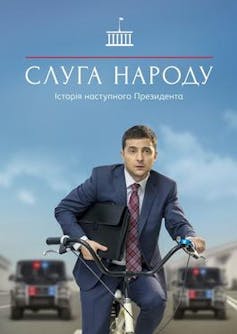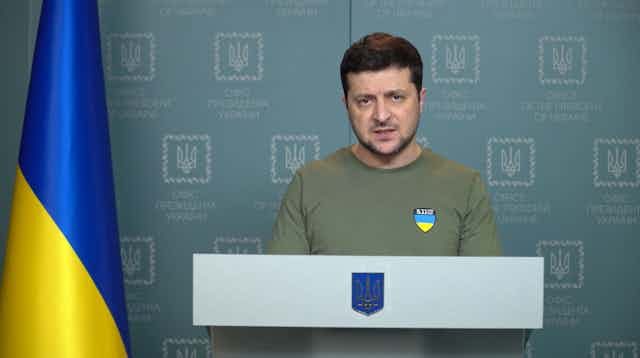Heading into battle in Ukraine, Russian forces mark their equipment with a single letter signifying their objective. There have been different interpretations of the letter “Z” being used on Russian vehicles – one is that it represents the first letter of “Za pobedy”, which means “For victory” in Russian. But for others, who saw Ukrainian president Volodymyr Zelensky describe himself as Russia’s “target number one”, the giant “Z” would seem to confirm that toppling Zelensky is first and foremost on Vladimir Putin’s otherwise unreadable mind.
Outside Ukraine, Zelensky has become the global figurehead and focus of Ukrainian resistance, something underlined by the British parliament’s recent decision to ask the Ukraine president to address MPs in the House of Commons via videolink.
Zelensky’s path to power could not be more different than that of the man pursuing him. Putin rose through the ranks of the KGB to build his power base under the chaotic leadership of former Russian president Boris Yeltsin. Meanwhile, the 44-year-old Ukrainian president, now embraced by the world and at home as a heroic war leader, was first an immensely successful comedian, film actor and sitcom star, who had perfected the role of the everyman.
Zelensky had no political experience when he ran for president in 2019. Born in 1978 in Russian-speaking Kryvyi Rih, a major (and heavily polluted) iron-mining town in southeast Ukraine, he is the son of a computer science professor and an engineer. His grandfather and three great-uncles fought in the Soviet army against the Nazis, with only his grandfather surviving. His great-grandfather and other relatives were murdered in the Holocaust.
At high school, Zelensky and friends entered Klub Vesyólykh i Nakhódchivykh (KVN). This is a young people’s comedy competition and TV show, loosely translated as the “Club of Funny and Inventive People”, that has remained immensely popular since its initial launch in the 1960s. Since being revived in the mid-1980s, teams from universities compete weekly on the highly rated show, which is something like “Saturday Night Live” meets “Britain’s Got Talent” – a Soviet culture relic that sends devoted viewers into hysterics across the post-Soviet expanse.
Comedian to president
While earning a law degree, Zelensky formed the “Kvartal 95” comedy troupe with his friends that toured in the KVN “major leagues”. By 2003, “Kvartal 95” began to produce shows for Ukrainian television and, by 2005, Zelensky was starring in films.
In 2006, he won Ukraine’s version of Dancing with the Stars, cementing his ability to gain the audience’s favour by reaching out through the camera. His most notable role by far was in the 2015-2019 television sitcom Servant of the People – after which he would name his political party.

In the sitcom, Zelensky played a high school history teacher, a Buster Keaton-style self-effacing character whose profanity-filled rant about corruption is recorded, unbeknown to him, and becomes a viral video that catapults the character into the presidency.
In Ukraine’s presidential election of April 2019, after a short campaign devoid of policy talk other than promises to fight corruption and bring peace to the Donbas, Zelensky managed to unseat incumbent president Petro Poroshenko. He won 73% of the vote – a remarkable and unprecedented feat in Ukrainian politics given that, as I detail in my book, Taxes and Trust, Ukrainians have a long history of deep distrust towards leaders. After his party won a parliamentary landslide a few months later, Zelensky held more political power than any politician in Ukraine’s 30-year history.
As president, Zelensky brought several “Kvartal 95” members into his administration, promoted online government service for all and perfected communicating directly to the public through social media. On the Donbas war, he initially believed that he just needed to negotiate directly with Putin.
But a preliminary deal announced by Zelensky in October 2019 – later withdrawn – met significant criticism both in Ukraine and overseas. It would have entailed calling for Russia to withdraw its troops, and elections in the separatist-occupied areas populated with few pro-Ukrainian voters that would have been viewed as heavily influenced by Russia.
End of the political honeymoon
In spring 2020, Zelensky rid his government of many pro-western reformers, including his prime minister and the head of the new National Anti-Corruption Bureau. Replacing them with less-experienced loyalists earned sharp condemnation. Meanwhile, Zelensky began to voice support for charges being raised against Poroshenko, who was indicted in January 2022 for treason related to a coal trade deal in the occupied Donbas.
Zelensky was criticised on the grounds that his support for the charges were tarnishing Ukraine’s international image at a moment of crisis as Putin’s soldiers mounted on the border. In 2020, Zelensky’s popularity ratings fell to the low 30s, although he remained the country’s most popular politician.
Corruption has been a long-standing problem for Ukraine, with Zelensky’s efforts to combat it broadly viewed as mixed. When he campaigned for the presidency in 2019, he was often linked to Ihor Kolomoisky, a Ukrainian oligarch who owns the channel that aired his hit sitcom and was once seen as a Zelensky supporter. But Zelensky refused to allow the reprivatisation of PrivatBank, once owned by Kolomoisky. In 2021, Zelensky successfully passed a law to stifle oligarch-owned media that was to go into effect later this spring.
Earlier, Zelensky also lifted legal immunity for parliament members, judges and the president and reinstated a law on illicit enrichment. In 2020, the presidency became embattled with Ukraine’s constitutional court, which threw out an assets-declaration system for politicians and judges required by international assistance agreements to uncover corruption, and deprived the National Agency for Preventing Corruption of much authority. Meanwhile, a year later, among many discoveries regarding political elites worldwide, the Pandora Papers revealed that Zelensky held offshore assets – although he denied any money-laundering.
Standing up to Putin
Zelensky’s opposition to Russia was building before the invasion. In February of last year, he took a stand against Putin by shutting down the television channels controlled by Vikor Medvedchuk, a Ukrainian oligarch, for pushing a pro-Kremlin narrative about the Donbas.
In April, with Putin building up his military along Ukraine’s borders, Zelensky asked Nato for Ukraine to be admitted quickly. In November, he accused another oligarch, Rinat Akhmetov, of collaborating with Russia to stage a coup.
Outside Ukraine, Zelensky might have been best remembered for his 2019 telephone call with the then US president Donald Trump, who unsuccessfully pressured Zelensky to investigate campaign rival Joe Biden’s son Hunter, which became the subject of Trump’s first impeachment.
But as Zelensky refuses to leave his capital and continues to rally his country in its existential struggle, that scandal likely will become a minor footnote in Z’s story.

